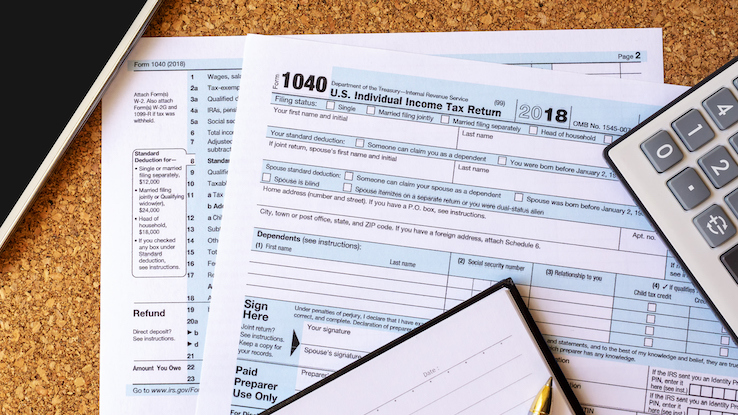If You Know Me Based on Years Ago

The American revenue enhancement system isn't known for being the most straightforward set of laws and processes to follow, and existence responsible for determining what you owe each twelvemonth can seem confusing — if not a trivial anxiety-inducing, also. Fortunately, you can quell some of your taxation-time worries by understanding how to estimate your yearly taxes. This manner, you can improve anticipate how your coin will be taxed, what you'll owe and even what you lot might go back from the government in the grade of a refund. Learn more about paying taxes in the U.S. at the federal level, forth with how to approximate your tax numbers.
The The states has what'due south called a progressive taxation system. This means that there are dissimilar income levels that get taxed at progressively higher rates and so paying taxes is less of a financial burden on people who earn less money. These levels are called brackets, and each one has a different pct associated with it. This percentage is the amount that's owed in taxes on any income that falls inside the boundaries of the bracket.

When you understand brackets, you lot'll have an easier time estimating what you may owe. Each tax subclass encompasses a dollar-amount range and serves every bit a cutoff point for the next pct level of taxation. You simply pay the tax bracket's percent on the corporeality of your income that falls into that bracket.
How Practise Brackets Piece of work?
To better sympathize brackets, information technology can assist to see an example. Imagine that there are four brackets: $0–$x,000, which is taxed at 0%; $10,001–$20,000, which is taxed at 15%; $xx,001–$30,000, which is taxed at 20%; and any income over $30,000, which is taxed at 25%. If y'all earn $9,000 a year in this instance, you won't owe taxes on information technology. If you earn $15,000 a year in this example, you'll pay xv% in taxes on whatsoever amount over $10,000 — $750, which is 15% of $v,000.

If you earn $twoscore,000 a yr, the situation gets a bit more complicated. Yous won't pay whatever taxes on the starting time $10,000, which leaves $30,000 in taxable income. You lot'll pay xv% in taxes on the $10,000 that accounts for the money you lot earn between $10,001–$20,000, for a total of $1,500. Then, y'all'll pay 20% on the $10,000 that falls between $20,001–$xxx,000, which is about $2,000. Finally, you'll pay 25% on the remaining $ix,999 for the $30,001–$40,000 amount of your income, which is a total of nearly $2,500. You don't pay 25% on your unabridged income simply considering the total falls into that bracket.
But the amount of income that falls within a detail bracket is taxed at that subclass'due south percentage rate. If you have a set salary and you look up a item tax year's bracket rates — the regime changes them sometimes, so information technology'due south important to bank check — you lot should have a relatively easy time estimating a general figure for what yous'll pay in taxes.
Reducing Your Taxation Liability With Deductions
For most taxpayers, there are some means to reduce the portion of income that's taxable. These are called deductions, and they can lower your overall revenue enhancement brunt and so you don't take to pay every bit much. One of the better-known of these is called the standard deduction, which is a ready dollar corporeality you tin can subtract from your income amount before computing what you owe in taxes on that income. This makes it so that your taxable income is usually less than the full income you earned for the year you're filing taxes.

Using the example in the section above, imagine now that the standard deduction is $10,000. You lot subtract this from your taxable income. This reduces your taxable income to $thirty,000 from $40,000. Equally a result, you'll no longer pay the 25% tax on the $ix,999 of your income between $xxx,001 and $40,000 because only $xxx,000 of your income is taxable. Instead, you'll pay $3,500 in taxes, which accounts for the 15% and xx% tax rates on your income that falls into two brackets between the $10,001 and $30,000 you lot earned.
Unless you lot cull to itemize your taxation return, which ways you decrease private amounts from dissimilar categories of expenses to lower your tax liability, you can better estimate your yearly taxes by subtracting the standard deduction before looking at bracket ranges.
Some other way to reduce what you lot pay in taxes is to apply tax credits. These differ slightly from deductions. Whereas deductions are amounts you subtract from your income total before you calculate the taxes on it, tax credits are amounts you tin can subtract from the full corporeality yous owe after y'all've calculated your taxation burden.

Some of the common taxation credits in the United States are related to dependent adults and children, education payments and the costs of homeownership. If you want to get your estimation narrowed down even further, yous tin make up one's mind which credits y'all're eligible for.
Once more, permit's use the numbers from the above examples. You've calculated that you'll pay near $3,500 in taxes based on your $xl,000 income and the fact that you're claiming the standard deduction. You also have a child who meets sure criteria, and this makes you eligible to claim a childcare tax credit that's worth $700. You'll subtract this $700 from $3,500 for a reduced total of $2,800.
Notice that you lot don't decrease the $700 from the $xxx,000 of your taxable income. You wait until y'all've calculated the amount you owe and subtract credits from that, not from the amount you've earned. Deductions come before, and credits come up after. Take some fourth dimension to research bachelor credits and whether you might qualify for them if yous're looking to get closer in your estimation.
Source: https://www.askmoney.com/taxes/how-to-estimate-your-yearly-taxes-based-on-your-income?utm_content=params%3Ao%3D1465803%26ad%3DdirN%26qo%3DserpIndex
0 Response to "If You Know Me Based on Years Ago"
Post a Comment